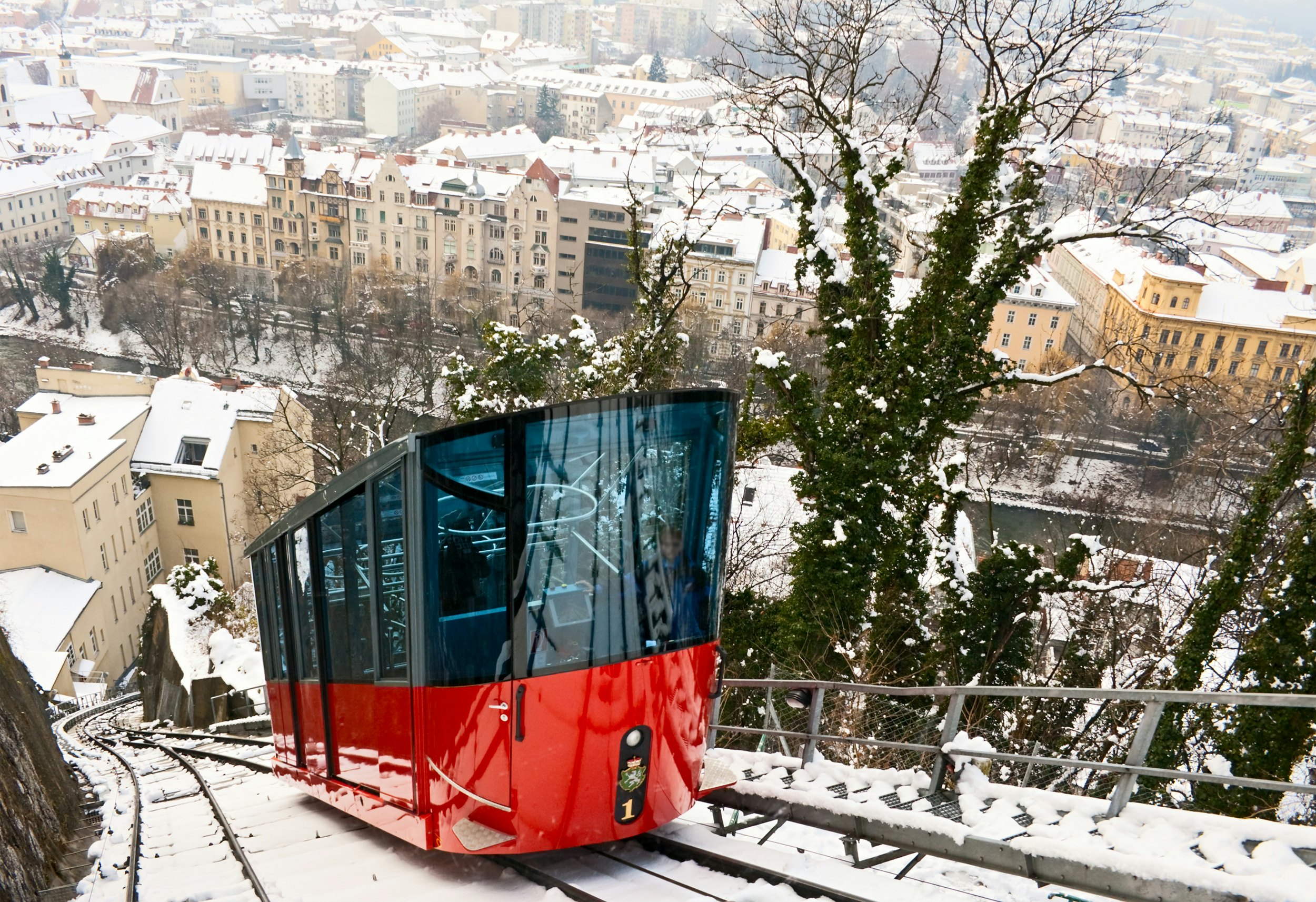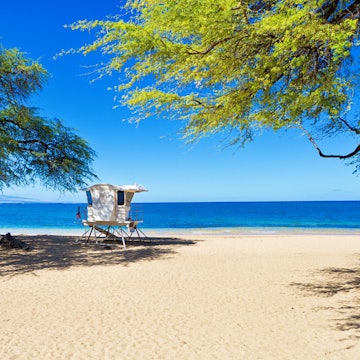

Gliding across the Tyrolean Mountains on a high-speed train is just one of the many transport options in Austria © traumlichtfabrik / Getty Images
Snugly landlocked in the center of Europe, Austria packs a stock of sights into its modest size.
Whether you start in cultural stronghold Vienna or alpine Innsbruck, here's how to navigate Austria’s stunning tapestry of highland valleys, mountain-encased lake districts, and history-stacked cities quickly and easily by public transport.
Travel by train on Austria’s high-speed rail
Nonstop domestic flights connect Vienna to Innsbruck in one hour, but why not ditch the plane and opt for environmentally friendly rail travel – in Austria, it's affordable, accessible and reliable.
National operator ÖBB boasts a network of over 5000km (3107 miles) that connects the nine federal states in Austria. The Railjet (RJ) trains are high-speed and best for crisscrossing the country; the faster Xpress (RJX) stops only at main city stations (Hauptbahnhof). Amenities include free wi-fi, comfy seats, luggage racks, power sockets, a restaurant car, and designated Quiet and Family Zones.
There are two Railjets per hour linking Vienna to Linz (1 hour, 15 mins) and Salzburg (2.5 hours), and one every hour taking you from Vienna to Graz (2 hours, 35 minutes) and Vienna to Klagenfurt (3 hours, 55 minutes). Intercity-Express (ICE) trains are the second fastest option, and ÖBB Nightjets (NJ) can save on accommodation costs, leaving Vienna in the evening and arriving in Innsbruck by early morning.
The regional (R) and regional express (REX), Intercity (IC) and Cityjet (CJ) trains are slower, stopping or interchanging at smaller towns between the main cities. S-Bahn (S) trains connect regional capitals to the surrounding provincial areas.
Private rail operator WESTbahn charts a standalone intercity connection between Vienna Westbahnhof station to Salzburg, Innsbruck and Bregenz. The highspeed, double-decker trains are packed with similar comforts, but the supersaver and flexible tickets are often cheaper than the ÖBB equivalent fare from Hauptbahnhof.

How and where to buy intercity train tickets
Book ÖBB trains online or at train stations. While standard fare tickets offer flexibility in departure time, advance-purchase Sparschiene tickets with a fixed time are often half or a third of the cost. Seat reservations cost €3.00 more each way but are worth booking on popular intercity routes or when traveling at peak travel times and days. Bikes are free to bring on regional trains; for long-distance trains, you must book a special ticket to reserve a space in the designated bike zone (2nd class carriage).
Save money on unlimited travel tickets
City Tickets are valid for one to seven days and allow unlimited travel on public transport, including regional R, REX, CJX and S-Bahn trains, trams and buses in the city core zone; single-day Leisure Tickets offer the same but within a specific state or region. However, these tickets are not valid on Railjet, Eurocity, Intercity, D, and Nightjet trains.
Subway systems in Austria
Vienna is the only city in Austria with a metro system and it's a great way to explore the neighborhoods surrounding the historic center. Five metro lines (U-Bahn) run from 5am to midnight on weekdays and 24 hours on Fridays and Saturdays. A sixth line is currently in construction. Maps are easy to read, and station announcements are also in English. All stations have wheelchair access.

Austria’s most scenic rail routes
The 41km-long (25 miles) UNESCO Semmeringbahn that trundles through the mountainous Semmering Pass between Gloggnitz in Lower Austria and Mürzzuschlag in Styria, across a 19th-century viaduct, is undoubtedly the most iconic train journey in the country. Other spectacular lines include Mariazellerbahn, Austria's longest narrow-gauge railway from St. Pölten to Mariazell through the Ötscher-Tormäuer Nature Park, the Zillertalbahn steam locomotive, and the country's steepest rack and cog railway, Schafbergbahn at St Wolfgang in the Salzkammergut.
Traverse the mountains on funiculars and cable cars
Hiking is one way to cross rolling valleys and clamber to peak panoramas, but Austria excels in its funicular, lift and gondola cable car fleet, moving you from ground to vista in minutes. Outside of ski season, mountain regions can have from half a dozen to 20 summer operations. However, the Hintertuxer Gletscher cable car in Tirol and Styria's Dachstein-Gletscherbahn full-glass panorama gondola are standout experiences. Pay at the cable car station or utilize the discount or free travel from city, regional and resort cards.
See more of Austria by bus
Austria’s most extensive service, Postbus (a subsidiary of ÖBB), is often combined with a rail transfer, connecting harder-to-reach places on alpine passes, lake region byroads, and hiking and biking trailheads.
Regional operators VOR in Lower Austria, Vienna and Burgenland, ÖOVV in Upper Austria, Salzburg Verkehr in Salzburgerland, Verbund Linien in Styria and Kärntner Linien in Carinthia connect the areas in and around the federal cities.
You can purchase a ticket from the driver upon boarding, but it's worth reserving a seat in advance for popular routes and during ski season.
Accessible travel in Austria
Railjet, Intercity and EuroCity services have wheelchair spaces, accessible toilets, train boarding ramps, and information announcements in German and English. You can request station and onboard mobility services for specific journeys with ÖBB’s online form. Around 400 train stations across Austria have lifts, ramps and mobility aids, and public transport in major cities is barrier-free.

Explore Austria on two wheels
Vienna and Salzburg have public bike rental schemes. Mountain bike, road bike and e-bike hire services are widespread across Austria (Intersport is a main outfitter) and you'll need to check which gondola routes allow bikes to be carried onboard. For the Danube Cycle Path, some hire stations in the starting point, Passau (across the border in Germany), allow you to drop the bike off around 300km (185 miles) later in Vienna.
Explore rivers and lakes by ferry
Passenger ferry routes and boat tours operate along the Danube on a route between Passau – Linz – Wachau – Vienna. There are also daily boat services on several larger lakes in Austria’s Salzkammergut region, including Wolfgangsee, Hallstätter See and Tirol’s Achensee. You can also take to the water in Wörthersee in Carinthia and Austria’s largest, Neusiedler See in Burgenland.
Create your own schedule on a road trip
Austria's most beautiful road trips open up when you leave the highways. The Romantic Road, linking Vienna to the vineyards of Wachau Valley and the Salzkamemrgut lake district, and the Grossglockner High Alpine Road, which hairpin bends through the Hohe Tauern National Park, are arguably two of Austria's best. Choose your favorite from our pick of the best road trips in the country.
However, when driving on motorways in Austria, you must display a physical Vignette toll sticker or get a digital sticker online (10 days/€4.60, two months/€11.50, one year/€38.50). Short-term parking zones across all provinces (indicated by street signage) are pay-and-display.
Drive on the right and overtake on the left; speed restrictions are 130km/h (80 mph) on motorways (Autobahn), 100km/h (62 mph) on expressways and open roads (Bundesstrasse) and 50km/h (31 mph) in residential areas. Legal requirements include always carrying your driving license and insurance papers, keeping a high-vis jacket in the car with a warning triangle and a first aid kit in case of a breakdown, compulsory seatbelts, and responsibility for passengers under 14 (including appropriate child seats).
Planning a trip to Austria? Here's more of our expert advice:
These top things to do should be on your itinerary
Explore the great outdoors on one of these incredible Austrian hikes
Pick the perfect time for your vacation with our seasonal guide
















